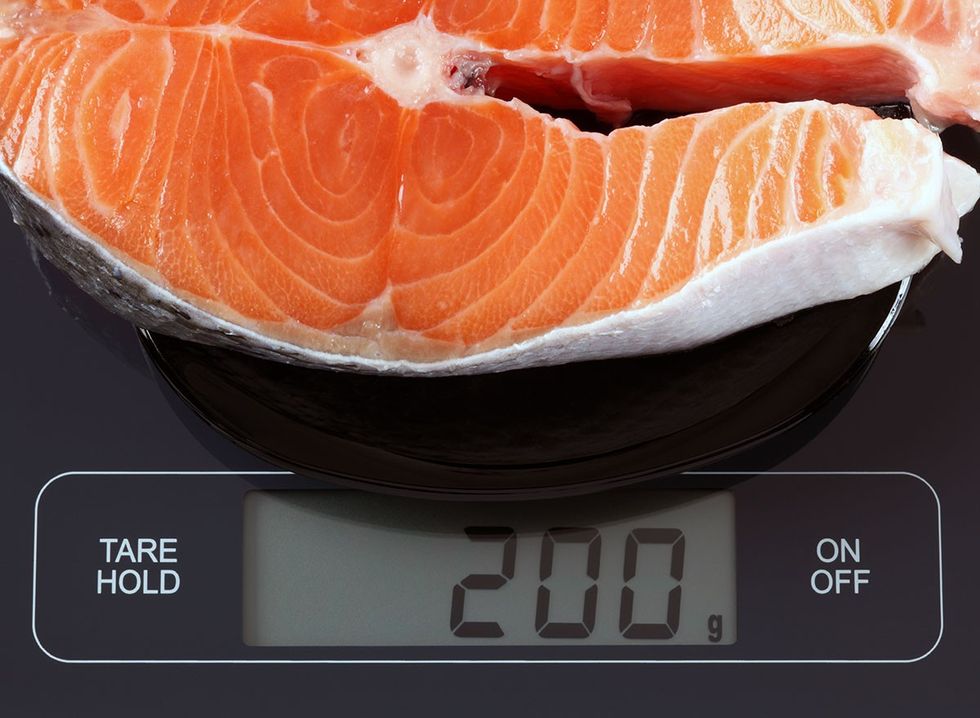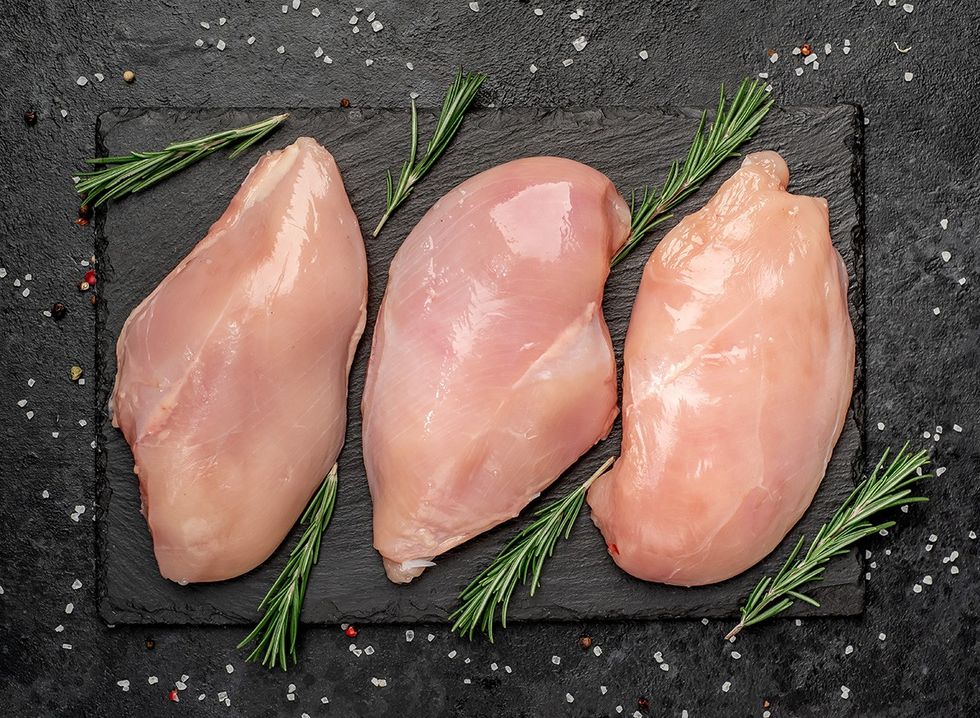Clinical nutritionist Autumn Bates is a weight-loss expert—and she knows how important adequate protein is for losing fat while building muscle. Bates believes most people have no idea how much protein they are supposed to be eating and are probably not getting enough. But that’s not all. “If you’re eating protein to help you achieve a weight loss goal, you want to make sure you’re doing it the RIGHT way,” she says. Here are five protein mistakes Bates says will undermine your weight loss efforts.
Mistake #1: Getting Enough Protein

Bates emphasizes the importance of protein for weight loss. “Protein has been studied to be extremely useful for achieving a body composition goal, which is where you're losing body fat but not losing muscle, and that's exactly what you want when you're looking to achieve a weight loss goal,” she says. “You don't want to lose muscle, you want to lose body fat, but not too many people are actually getting enough protein to reap those body recomposition benefits.”
USDA Guidelines
Bates believes most people simply need to get more protein. “Most people think they're getting more than enough, and unfortunately, this is based on the USDA guidelines, amount of protein needed per day, which is 0.8 grams per kilogram of body weight,” she says. “This amount was never intended to be like a golden rule for how much protein you need to perform and achieve weight loss goals maximally.”
How Much Protein?

Bates makes the point that the protein guidelines were to prevent deficiency. “In reality, those studying protein find that a minimum of one gram of protein per kilogram of body weight is needed. And even this is still low for most people, even if you're just moderately very, very low level of activity. In reality, it's closer to 1.2 as a minimum. And if you are active or exercising, you're going to want about 1.6 grams per kilogram body weight, which is double the amount of protein that the USDA guidelines recommend, which, duh, why no one sees those benefits of protein when they're consuming half of what they need.”
Mistake #2: Not All Proteins Are Equal

Bates says not all proteins should be counted towards your protein goals. “For example, collagen is often used in smoothies as a protein source when it's not actually a complete protein,” she says. “So your body doesn't use it in the same way that it would like Greek yogurt or whey protein. So when working towards your protein needs per day, you want to make sure that the vast majority of that's coming from complete protein sources, otherwise, you're not actually really getting those body root composition perks that you're looking for.”
Plant-Based Protein

Bates says vegans and vegetarians need to make sure they get the best plant-based protein possible. “If you do eat animal products, it's pretty easy to make sure you're getting complete sources from fish, yogurt, eggs, chicken, meat,” she says. “But if you're purely plant-based, you want to make sure that you're opting for the highest quality protein sources available to you, which means prioritizing complete proteins from plant-based sources. So this would be things like from protein powders or fermented soy products, and also making sure that it's a high DIAAS protein, which is really just a scoring system.”
Mistake #3: Serving Size
Bates says many people do not use the right serving size when it comes to their protein powder. “Oftentimes with something like whey protein powder typically requires two scoops for one serving,” she says. “Many plant-based protein powders on the other hand, are usually going to be one scoop a serving. But because of this, if you're going from a plant-based protein and switching to whey protein, you might just assume that one scoop is one serving, and then you're only getting half of what you intended. So just make sure you check what the actual serving size is if you're using protein powders so that you're getting what you're intending on getting.”
Mistake #4: Protein and Age

Bates says many people need to get more protein as they get older. “It's assumed that because you're maybe less active you don't need as much protein,” she says. “This is not true. In fact, your needs are likely about 25% higher than they used to be. This is because as we age, we start to lose bone and muscle pretty quickly. So you're already working in essentially a protein deficit. So, for most people, when you start to experience bone loss at an accelerated rate, usually around the age of 50, you really want to make sure that you're hitting your daily protein needs from complete sources. So this might be more on the side of 1.6 grams of protein per kilogram of body weight.”
Mistake #5: No Protein On Hand

Bates says if protein isn’t available and ready to eat, you will eat less of it. “Protein tends to be the most time-consuming to prep, especially from animal-based sources where you need like 20 or 30 minutes if you're baking,” she says. “And if you're in a pinch and you just need something, you need to make sure you have vast, easily available protein sources, preferably that are pre-cooked.”
Easy Protein

Bates says to keep protein powder on hand, as it’s easy to make a smoothie or stir into yogurt. “Hard-boiled eggs or those pre-cooked egg bites, Greek yogurt cottage cheese, which I've actually seen, there are even plant-based Greek yogurt options now that are actually high in protein,” she says. “And then rotisserie chicken is really great because it's pre-cooked and all you have to do is hair off pieces and add it into your lunch, and you're good to go.”
Portable Protein

Bates has great suggestions for protein on the go. “Beef sticks are another one, especially if you're traveling, that can be really easy to take with you,” she says. “But it also comes in turkey, and I think there's salmon options too. Another really great option for a fast protein source would be canned tuna or really canned fish in general. But one of my favorite fast, easy, high protein options is a smoothie because you can just dump everything into the blender, blend it up, and you can just take it with you.” And if you enjoyed this article, take advantage of these 15 Quick Ways to Lose Body Fat Percentage in a Week.

























 I'm a Nutritionist and These 9 High-Protein Snacks Keep My Clients Full While Losing 50 Pounds
I'm a Nutritionist and These 9 High-Protein Snacks Keep My Clients Full While Losing 50 Pounds
 Shutterstock
Shutterstock 2. Processed FoodsShutterstock
2. Processed FoodsShutterstock Shutterstock
Shutterstock Shutterstock/Prostock-studio
Shutterstock/Prostock-studio Shutterstock
Shutterstock Pro TipsShutterstock
Pro TipsShutterstock Shutterstock
Shutterstock Shutterstock
Shutterstock Shutterstock
Shutterstock Shutterstock
Shutterstock Don’t Drink as Much AlcoholShutterstock
Don’t Drink as Much AlcoholShutterstock Most Women on GLP-1s Are Making a Few Common MistakesShutterstock
Most Women on GLP-1s Are Making a Few Common MistakesShutterstock Soda and Sugary DrinksShutterstock
Soda and Sugary DrinksShutterstock Shutterstock
Shutterstock Eat BreakfastShutterstock
Eat BreakfastShutterstock And Improve Insulin SensitivityShutterstock
And Improve Insulin SensitivityShutterstock Belly Flab Strip Tip: Sugar and Fat Calories Leave Its Mark on Your BodyShutterstock
Belly Flab Strip Tip: Sugar and Fat Calories Leave Its Mark on Your BodyShutterstock Shutterstock
Shutterstock The Drugs Mimic the GLP-1 Hormone Naturally Produced by the BodyShutterstock
The Drugs Mimic the GLP-1 Hormone Naturally Produced by the BodyShutterstock 3. Deep-Fried ItemsShutterstock
3. Deep-Fried ItemsShutterstock